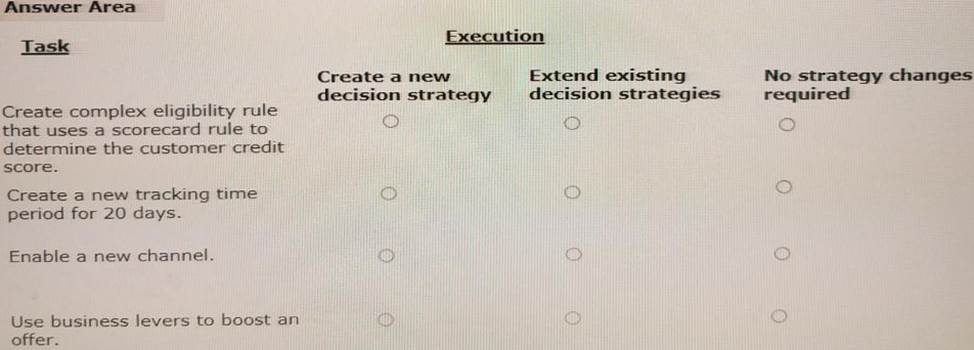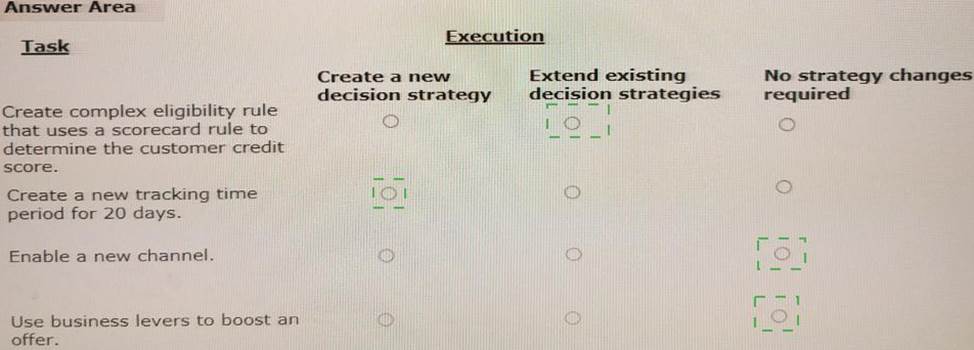Pegasystems PEGAPCDC86V1 Pega Certified Decisioning Consultant (PCDC) 86V1 Online Training
Pegasystems PEGAPCDC86V1 Online Training
The questions for PEGAPCDC86V1 were last updated at Jul 18,2025.
- Exam Code: PEGAPCDC86V1
- Exam Name: Pega Certified Decisioning Consultant (PCDC) 86V1
- Certification Provider: Pegasystems
- Latest update: Jul 18,2025
MyCo, a telecom company, notices that when customers call to check on bill status, 80% of the time, they received the wrong offer promotion, leading to customer dissatisfaction. The company decides to boost customers’ needs in the prioritization formula, to improve sales in the current quarter.
Which arbitration factor do you configure to implement the requirement?
- A . Context weighting
- B . Propensity
- C . Business weighting
- D . Action value
MyCo, a mobile company, uses Pega Customer Decision Hub™ to display offers to
customers on its website. The company wants to present more relevant offers to customers based on customer behavior. The following diagram is the action hierarchy in the Next-Best-Action Designer.

The company wants to present offers from both the groups and arbitrate across the two groups to select the best offer based on customer behavior.
As a decisioning consultant, what must you do to present offers from the two groups?
- A . Enable an engagement policy for the second group.
- B . Set contact limits for both the groups.
- C . Map a real-time container to the Top-level or Issue-level.
- D . Create a decision strategy at the Issue-level.
U+ Bank wants to offer credit cards only to customers with a low-risk profile. The customers are divided into various risk segments from AAA to CCC. The risk segmentation rules that the business provides use the Age and the customer Credit Score based on the following table. The bank uses a scorecard model to determine the customer Credit Score.

As a decisioning consultant, how do you implement the business requirement?
- A . Add the risk segmentation rules in the Results tab of the scorecard rule.
- B . Add a decision table to a decision strategy and pass the credit score as the parameter.
- C . Add a decision table to a decision strategy and reference it in the scorecard component.
- D . Add three contact policies that correspond to the three risk segments.
U+ Bank, a retail bank, wants to send promotional emails related to credit card offers to their qualified customers. The business intends to use the same action flow template with the desired flow pattern for all the credit card actions.
What do you configure to implement this requirement?
- A . Output template
- B . Dynamic template
- C . File template
- D . Email treatment
U+ Bank has recently introduced a few mortgage offers that are presented to qualified customers on its website. The business now wants to prevent offer overexposure, as overexposure negatively impacts the customer experience.
Select the correct suppression rule for the requirement: If a customer is presented on the website with the same offer five times in the last 14 days, do not show the same offer to that customer for the next 10 days.
- A . Suppress an action for 10 days if there are five impressions for any channel in the last 14 days
- B . Suppress a group of actions for 10 days if there are five impressions for any channel in the last 10 days
- C . Suppress an action for 10 days if there are five impressions for web channel in the last 14 days
- D . Suppress an action for 14 days if there are five rejects for web channel in the last 10 days
Myco, a telecom company, uses Pega Customer Decision Hub™ to present offers to qualified customers. The business recently decided to send offer messages through the email channel. The Design department has designed an email treatment which includes dynamic placeholders.
As a decisioning consultant, what do you use in order to test the visualization and the rendering of the email content, including replacing of the placeholders with customer information?
- A . a list of customer email addresses from the Test Message tab
- B . schedule an outbound run with a limited number of customers
- C . preview section from the email content editor
- D . a seed list from the Test Message tab
U+ Bank uses Pega Customer Decision Hub™ to display an offer to its customers on the U+ Bank website.
The bank wants to ensure that Silver credit cards are not offered to customers under 27 years of age. They also want to ensure that Platinum cards are offered only to customers who had a positive balance in the last year.
What do you configure in the Next-Best-Action Designer to achieve this outcome?
- A . Engagement policies
- B . Contact policy rules
- C . Customer segments
- D . Arbitration rules
U+ Bank, a retail bank, presents various credit card offers to its customers on its website. The bank uses artificial intelligence (AI) to prioritize the offers based on customer behavior. Since introducing the Gold credit card offer, the offer click through rate propensity has increased to 0.83.
What does the increase in the propensity value most likely indicate?
- A . Similar customers have ignored the offer.
- B . Similar customers have shown interest in the offer.
- C . Similar customers have rejected the offer.
- D . Similar customers have purchased other offers.
U+ Bank’s marketing department currently promotes various home loan offers to qualified customers. Now, the bank does not want to show offers on a customer’s account page if the customer has already received three home loan offers in the last two weeks.
What do you need to define to implement the business requirement?
- A . Customer contact limits
- B . Suppression policy
- C . Volume constraints
- D . Applicability rules
HOTSPOT
U+ Bank, a retail bank, presents offers on its website by using Pega Customer Decision Hub™. The bank wants to leverage Customer Decision Hub capabilities to present relevant offers to qualified customers. As a decisioning consultant, you are responsible for configuring the business requirements with the Next-Best-Action Designer, which involves several tasks. To accomplish these tasks, you might have to use auto-generated decision strategies, create new decision strategies, or edit existing strategies.
In the Answer Area, select the correct execution for each Task.


Latest PEGAPCDC86V1 Dumps Valid Version with 60 Q&As
Latest And Valid Q&A | Instant Download | Once Fail, Full Refund

